

Damion Smy
GWM Cannon Alpha ute, Tank 300 HEV and Tank 500 recalled
13 Hours Ago
A hybrid-powered, all-wheel-drive crossover is an interesting compact-sized amalgamation. But does the Yaris Cross AWD Hybrid stack up to the sum of its parts in the experience?
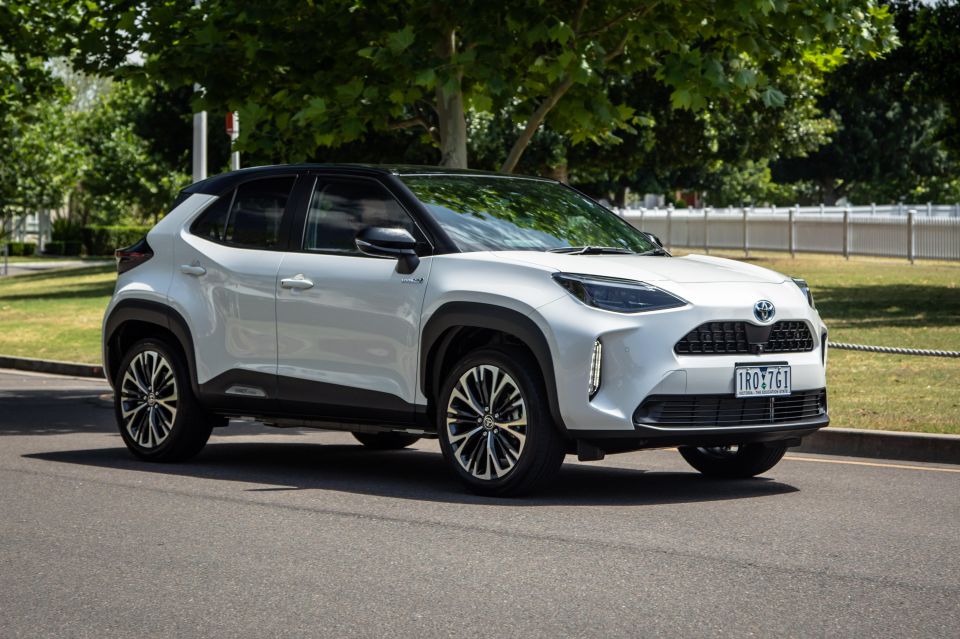
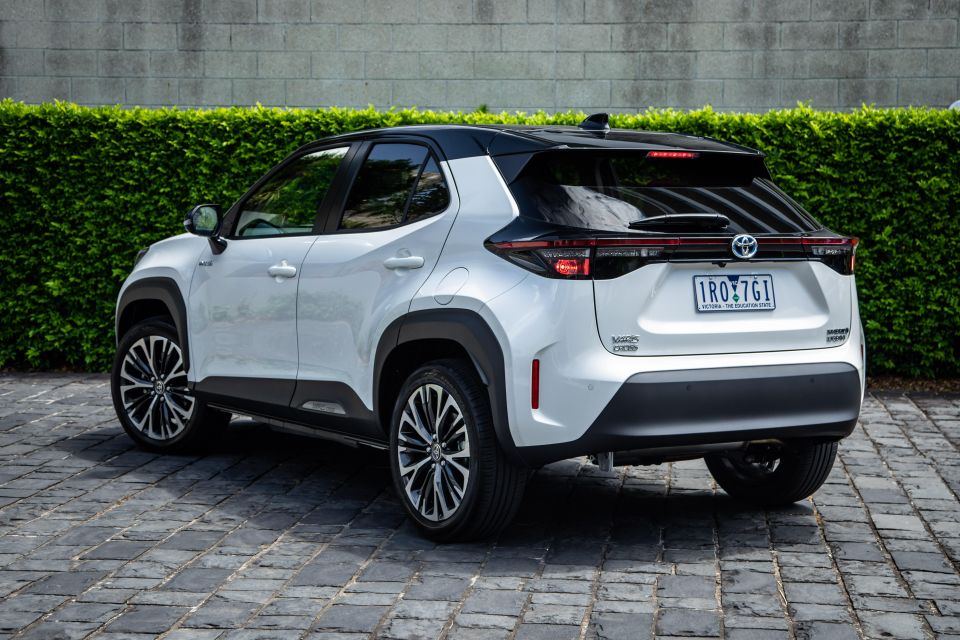

Journalist
New from
$31,990
excl. on-roads

Journalist
New from
$31,990
excl. on-roads


Journalist
New from
$31,990
excl. on-roads

Journalist
New from
$31,990
excl. on-roads
Quickly see how this car stacks up against its competition. Select any benchmark to see more details.
Where expert car reviews meet expert car buying – CarExpert gives you trusted advice, personalised service and real savings on your next new car.
It seems Aussies are increasingly less interested in cheap and cheerful compact cars.
According to one recent statistic some 53 per cent of private light/small passenger car and SUV sales sat in a $24,000 to $34,000 band in the year to July 2020. So it’s of little wonder a smart player such as Toyota is throwing a slew of petite model lines further upmarket than what was once considered ‘affordable’.
Take the recently launched Yaris hatch, for example. “My look at those prices,” the media says, but bums in seats do the real talking.
Enter the related Yaris Cross, almost unrecognisable against the hatch it shares much of its DNA with. It’s an all-new subcompact crossover to sit under – and just under – the C-HR, itself sliding neatly below the forthcoming Corolla Cross that’ll live beneath RAV4.
That’s three SUVs before you get to the Yaris, Corolla in a choice of sedan or hatch body styles, and a couple of different-sized Priuses that are categorically small or smaller still.

With a pragmatic view, it’s logical to ask why Aussie buyers might want a Yaris Cross when there’s C-HR sat in the same showrooms. Sure, the newcomer might be cheaper at its entry point ($26,990 plays $30,915) but they appear to ask for similar money scaling upwards through their respective ranges (through to $37,990 and $37,665 respectively).
The answer is: look at it. The Yaris Cross presents an inimitable vibe, a unique boxy styling direction and an altogether different pitch to the Yaris hatch regardless of some technical commonality. Sure, it’s a little smaller than C-HR – 180mm in length, 30mm in width, 5mm in height – but comparative size to stablemates is somewhat immaterial.
The Yaris Cross wants to bring a new twist to pint-sized runabout motoring, and our flagship Urban test version is the model at its most promisingly flexible.
It’s an SUV-like package with crossover spunk, jacked-up all-paw underpinnings, and hybrid drive, a sort of compact Swiss army knife its maker hopes offers a fresh enough spin to appeal to newcomers to the brand, while of course not cannibalising sales from elsewhere in its range.
Needless to say, to achieve its aims it ought to be at least the sum of its cocktail of parts in the experience.
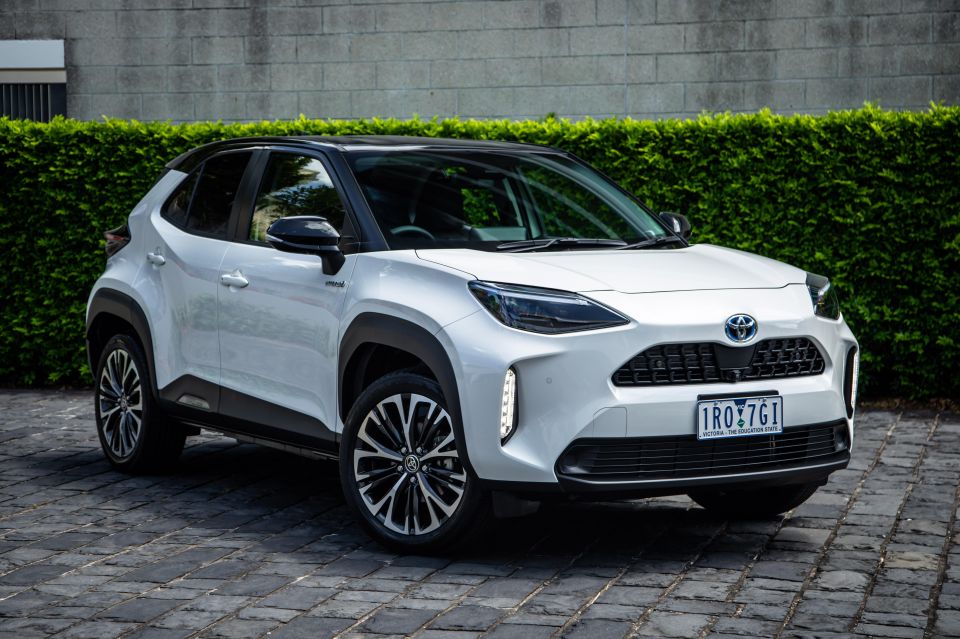
Remember how we said Yaris hatch was a little rich? Well, the Yaris Cross digs around $5000 deeper into your hip pocket across its nine-variant range. And our Urban AWD Hybrid version, as the range-topper, clocks on at $37,990 before on-roads.
This sort of money will land you the ultimate C-HR Koba in AWD ($37,165) or FWD Hybrid ($37,665) but not any combination of that pair’s power and drive.
Similarly, the hybrid SUV thing is covered by the RAV4 GX ($37,070) if in base-model front drive. But if you’re primarily wedded to Toyota ownership, the list of alternative models available on a $38,000 budget cap beggars belief.
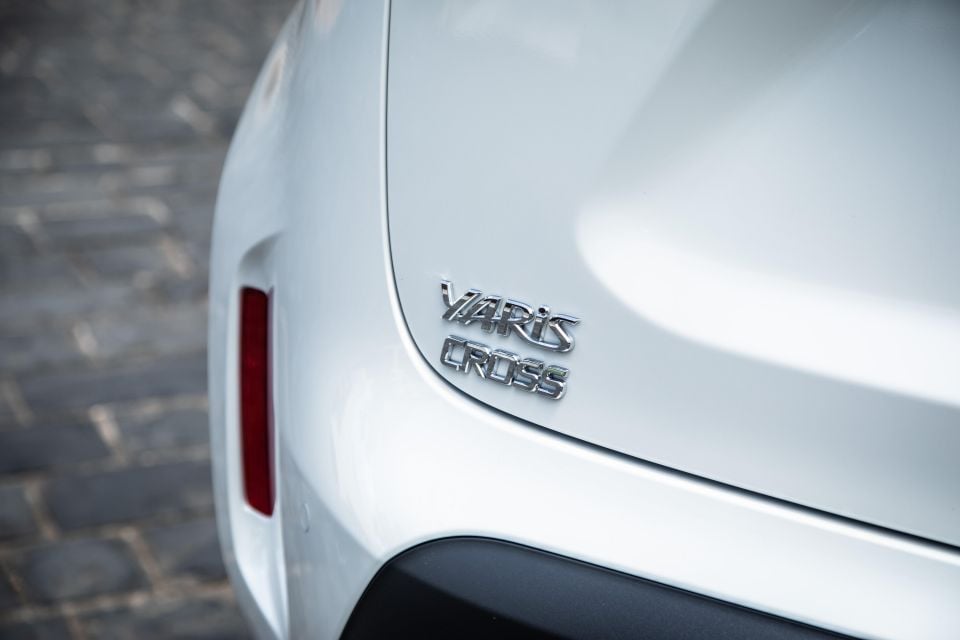
Other small, compact or light SUV, crossover or hatch options? Too numerous to list.
But you’ll need a bit of extra outlay to stretch to a proper premium badge in the likes of base Audi Q2 35 TFSI ($41,950) or Mini Cooper Countryman ($42,200) and there’s not much else out there for Urban Hybrid money tying hybrid power with all-wheel drive beyond entry RAV4s and Subaru Foresters at around $40,000 apiece.
Opting for front drive rather than on-demand all-wheel drive wipes $3000 from the sticker price while Urban kit in regular front-driven petrol form is a much more palatable $32,990 before on-roads. Whichever version you choose, premium paint is $500 with a further $450 up-charge for a two-tone finish.
MORE: 2021 Toyota Yaris Cross pricing and specs

Buy your new car without the stress. It's fast, simple and completely free.

Great service from Travis and team, second time I have used this business would not hesitate to recommend them to anyone
Craig C.
Purchased a Ford Ranger in Sunshine Coast, QLD
CarExpert helped Craig save thousands on his Ford Ranger, now let us save you on your next new car.
Find a dealClearly, you’re partly buying into the combined effect of stylised design, soft-roading rhinoplasty, jacked up ride height and some of the sharpest-looking 18-inch wheels Toyota offers. Unlike the torsion beam arrangement on front-drive versions, the AWD Yaris Cross variants get multi-link rear suspension.
The flagship Urban gets front and rear LED lighting, power-folding mirrors, rain-sensing wipers, front and rear parking sensors, one-touch electric windows in both rows, rear privacy glass, and a powered tailgate with foot-activated gesture control.
Inside the seat trim is a combination of fabric and faux leather, with driver’s-side electric adjustment, front seat heating, LCD instrumentation, a head-up display, keyless go, single-zone climate control and, in our test car, a two-tone brown-grey cabin colour scheme. The Hybrid AWD doesn’t fit a spare wheel but does get an inflator kit.

Infotainment wise, the 7.0-inch touchscreen includes sat-nav, DAB+, a multi-view reversing camera, the choice of Apple CarPlay/Android Auto, ‘Miracast’ mirror link or Toyota App-link connectivity along with six-speaker audio.
Much like the new top-spec Yaris ZR hatch, the Yaris Cross Urban trim level offers a pleasing array of features covering most bases without bringing much different and unique to landscape.
It’s a shame leather trim, dual-zone climate control, rear air vents and few more device power sources are left off the list of a compact car so close to $40,000.
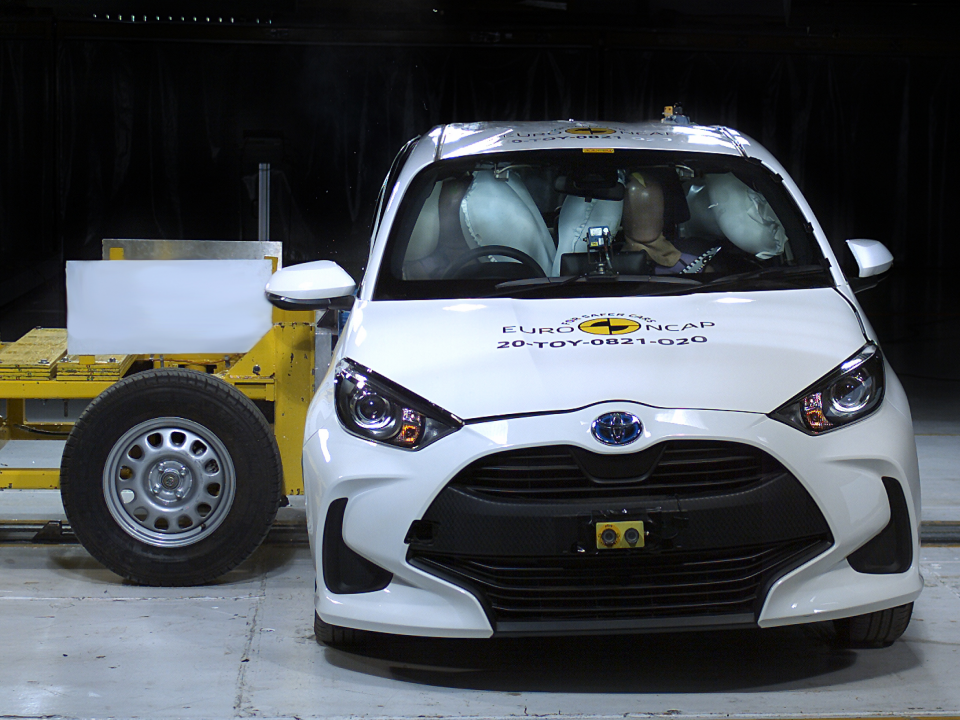
Unsurprisingly, the technical safety spec is similar to that of the Yaris hatch. But although the hatchback has been awarded five stars by ANCAP off the back of Euro NCAP testing, the technically related Yaris Cross remains unrated, though is expected to perform well once it does.
Equipment includes a complement of eight airbags, the Toyota Safety Sense suite of features that includes all-speed forward AEB with day/night sensing and pedestrian and cyclist detection, forward collision warning, brake assist, Parking Brake Support – to minimise or avoid impacts with stationary objects in forward or reverse – as well as blind-spot monitoring.
There’s more. Lane departure warning and lane tracing – auto correcting to keep you centred in a lane – are featured, as is Emergency Steer Assist to avoid pedestrian collisions, and Intersection Assistance to help prevent crashes with oncoming traffic turning left and right.
Speed sign recognition, adaptive cruise control the aforementioned auto high-beam and 360-sensor parking assistance all bundle up onto in helluva tech-laden package chock-full of safety and related convenience and assistance.
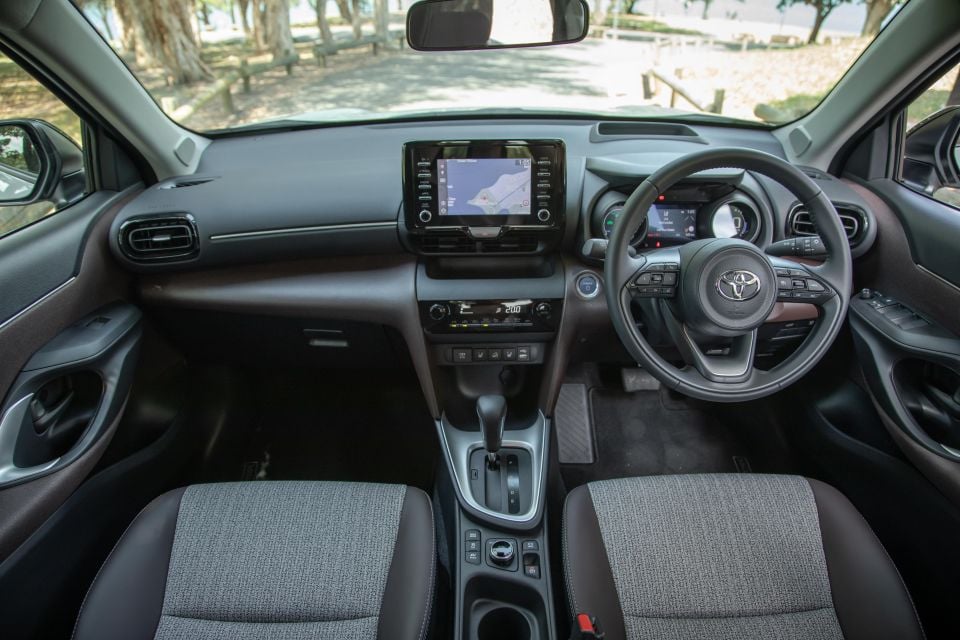
I’m a big fan of the ‘Danish tree log’ two-tone trim and not simply because it reminds me of the chocolate-almond-marzipan treats Mum makes each Christmas. It brings warmth, interest and individuality to the cabin.
Extending the brown colourisation through half of the stylised dash fascia and the felt-like door inserts anchors the effect, though it seems a missed trick contrasting much of it with drab grey – half the dash, the steering wheel, the whole rear door cards – rather than a darker shade of the central seat trim.
Presentation is quite decent, especially the double seat stitching and satin-finish switchgear, and the Cross carries over the funky ‘conical’ LCD instrumentation design of the new Yaris hatchback. With an eco-meter, of sorts, the left roundel and tachometer in the colour head-up display it’s an interesting alternative to trendy digital flat-screen instrumentation. Other Yaris cues include the unusual door handle ‘pods’ that look the part if offer questionable ergonomic friendliness.
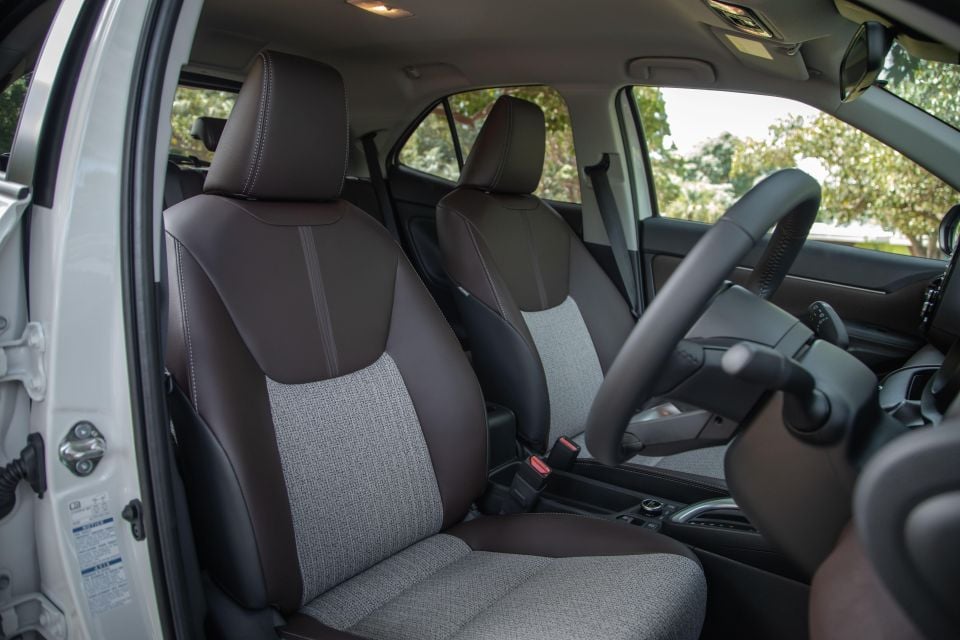
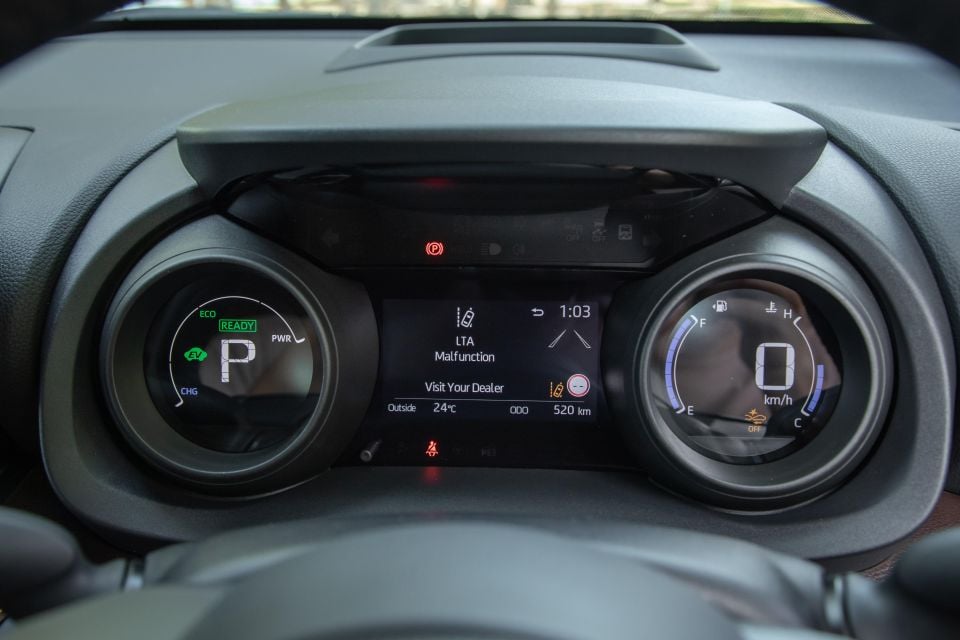
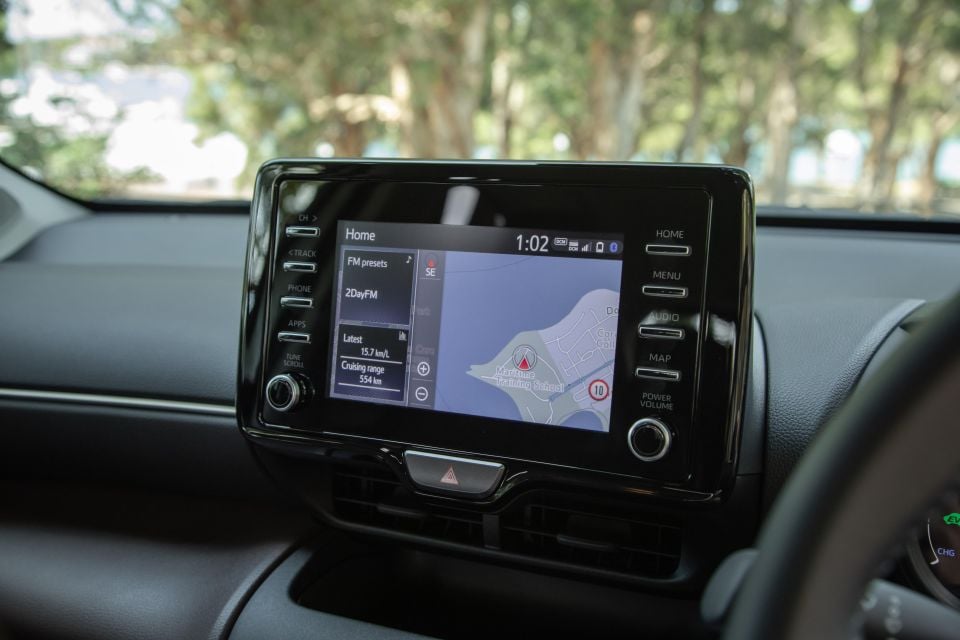

Nice steering wheel, comfy seats, a lot of clear outward visibility – the Yaris Cross front row is a decent place to spent time. The only real markdown is a lack of centre armrest. There’s no inductive charging but you do get dual USB ports and two cubby trays to store your phone and the doors have large bins large enough for bottles.
Infotainment is adequate. The standard sat-nav, DAB+ radio and smartphone mirroring inclusions are an improvement over the brand’s recent era of forced Toyota AppLink dependence – the clunky app-based format is still included for user still willing to subscribe and go through the laborious sign-up process.
Armed with large shortcut buttons and a volume knob it’s a functional enough system, though the small screen, dull graphics, and occasionally unresponsive and laggy touch interface hardly the last word in connectivity.
The rear accommodation is tight, if only realistically in legroom for the compact SUV crossover. Head, shoulder, and toe room is actually not bad for adults provided you treat the Yaris Cross as a four-seater – despite seatbelt count, vehicles this small aren’t realistically five-adult prospects.
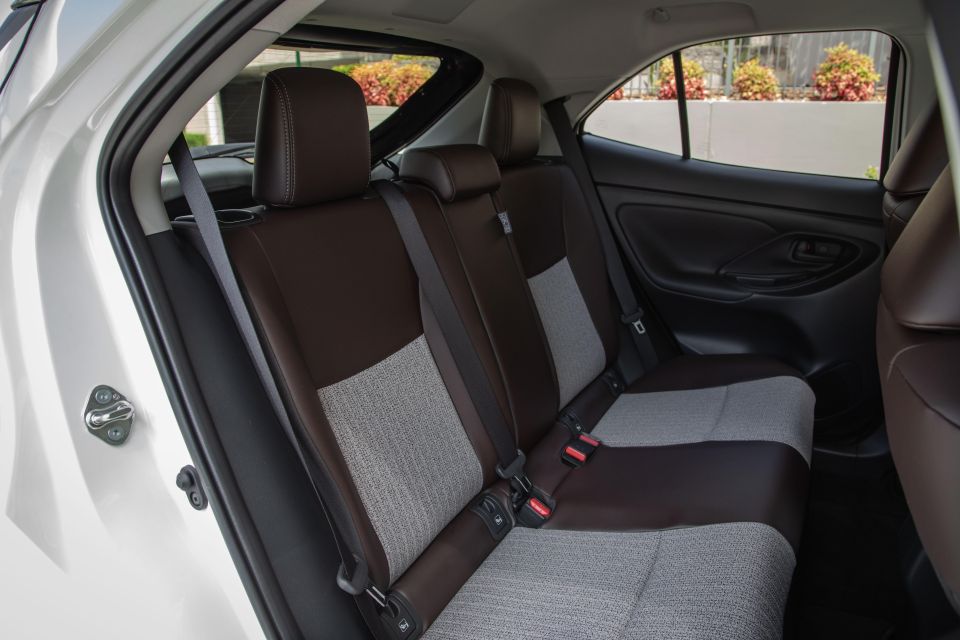
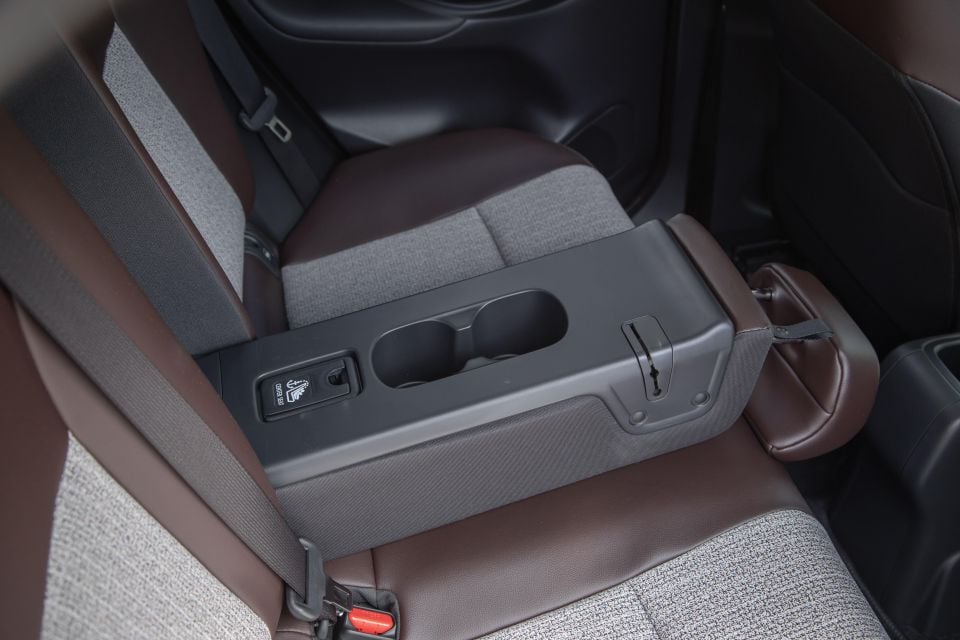

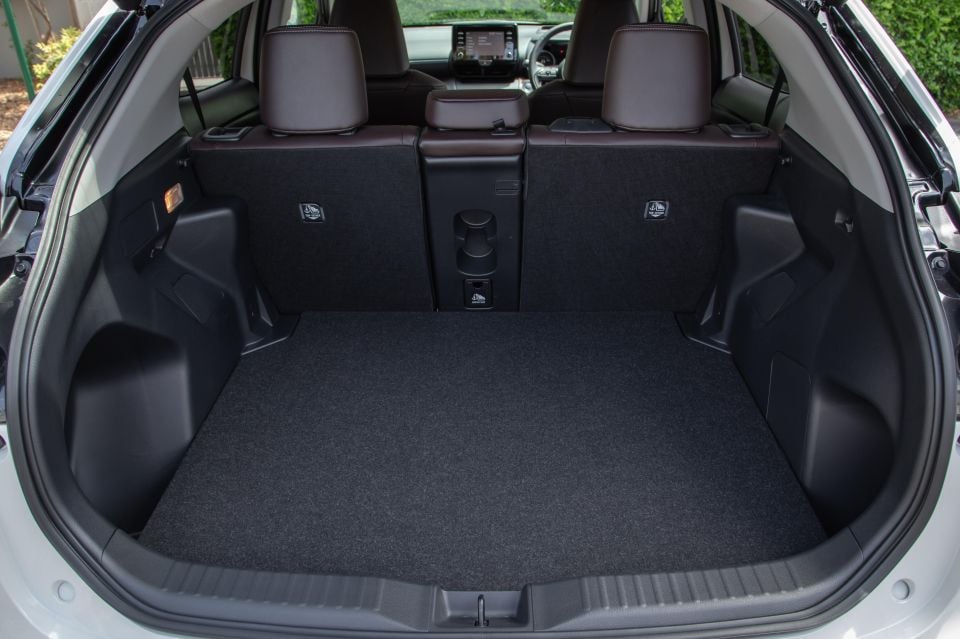
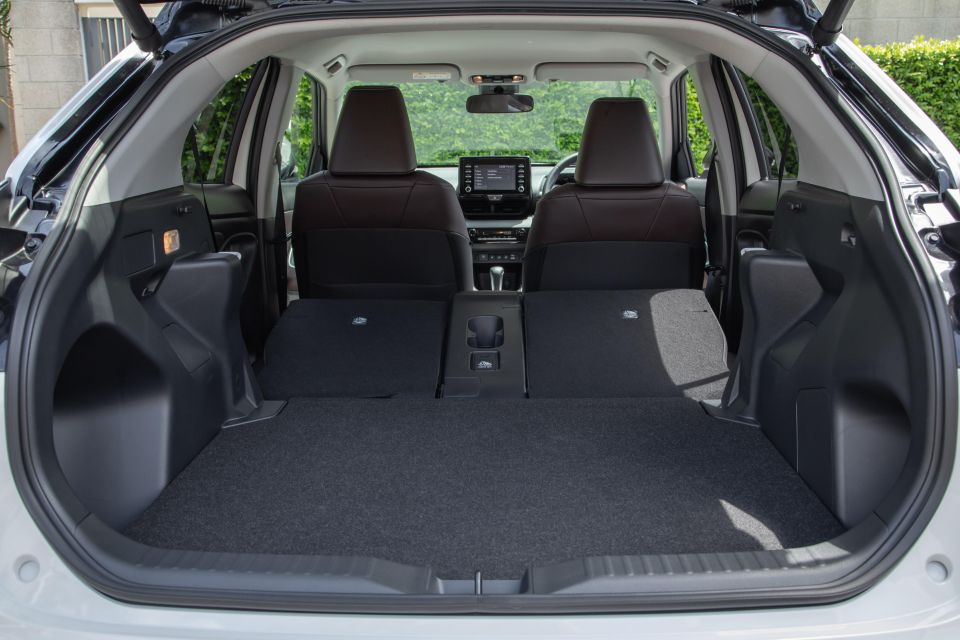
The lack of rear air vents, device power, or even overhead grab handles is a bit of an own goal, though you do get a novel fold-down armrest with dual cupholders that’s essentially the centre seat back assembly, exposing a hole through the luggage space.
The AWD’s boot space is 314 litres, quite a bit smaller than the 390 litres of the front-drivers. You also lose the space-saver wheel as fitted to the two-wheel drives.
There’s 40:20:40 split-fold expansion with a surprisingly handy, easy to stow fabric parcel shelf, a high floor and a couple of token grocery bag hooks. Under the floor sit a huge piece of Styrofoam with a modest inflator kit and no space saver spare, presumably because underneath sits some of the rear-axle e-motor hardware.
The powered tailgate is neat inclusion, if only it didn’t beep so loudly in operation, much like so many of the Yaris Cross’s seemingly incessant audible warnings. On this, since when did a ‘check the rear seat’ reminder on shutdown and exiting become such a constant and pervasive annoyance?
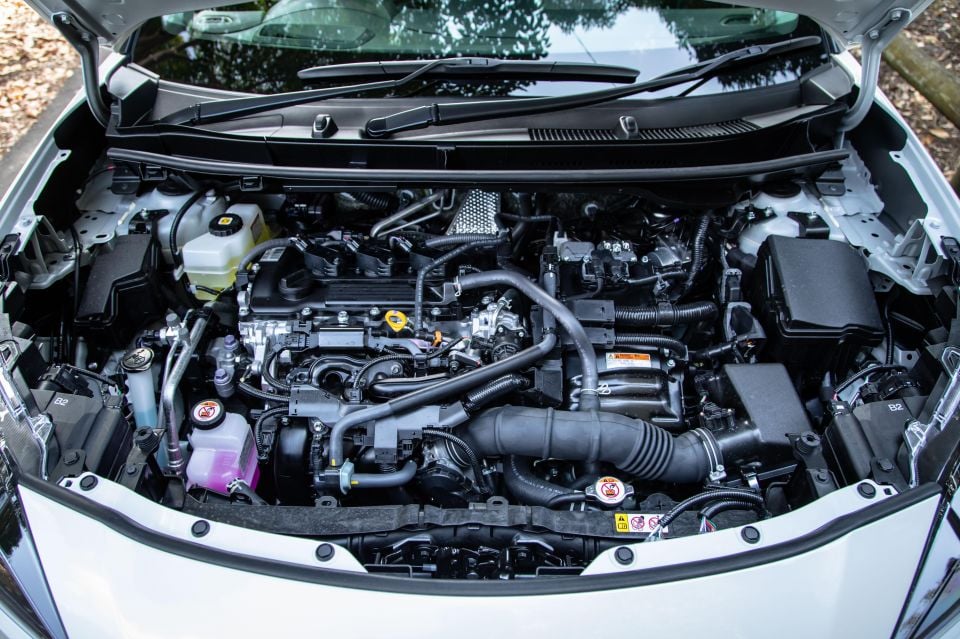
It’s quite a complex powertrain arrangement. The hybrid system’s three-cylinder 1.5-litre petrol Atkinson Cycle engine alone produces 67kW at 5500rpm and a modest 120Nm between 3800-4800rpm. That’s a bit down against the dedicated petrol variant’s 88kW/145Nm 1.5-litre three-pot.
Drive is supplemented by two electric motors offering both parallel and series drive. The ‘series’ motor drive the front axle in tandem with the petrol engine, makes 59kW and 141Nm, for a quoted system power output of 85kW (Toyota hasn’t quoted total system torque). Drive is directed to the front wheels only via a CVT transmission.
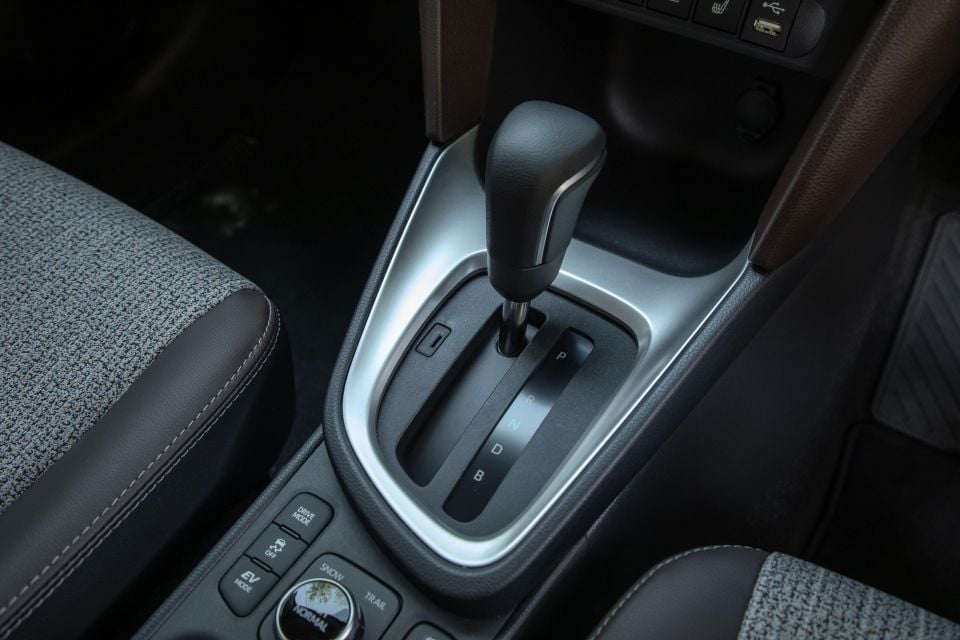
All-wheel drive versions add an on-demand ‘parallel’ motor on the rear axle producing a paltry 3.9kW and 52Nm, though its role is to benefit varied-condition traction rather than supplementing performance. The Yaris Cross also uses a lithium-ion battery of 4.3Ah capacity rather than the nickel-metal hydride design Toyota has traditionally favoured.
The upshot of the hybrid system? Against the petrol version’s already handy 5.4L/100km combined claim the petrol-electric format drops the combined consumption claim to 4.0L/100km in all-paw versions (3.8L/100km FWD). It runs happily on 91RON fuel too and, of course, there’s no plug-in recharging required.
The readout on the in-dash computer displayed between 25.0kms/L and 23.6kms/L after resetting and checking twice – or 4.0L to 4.2L per 100 kilometres in more familiar conversion – which is bang on ins maker’s claim. Nice.
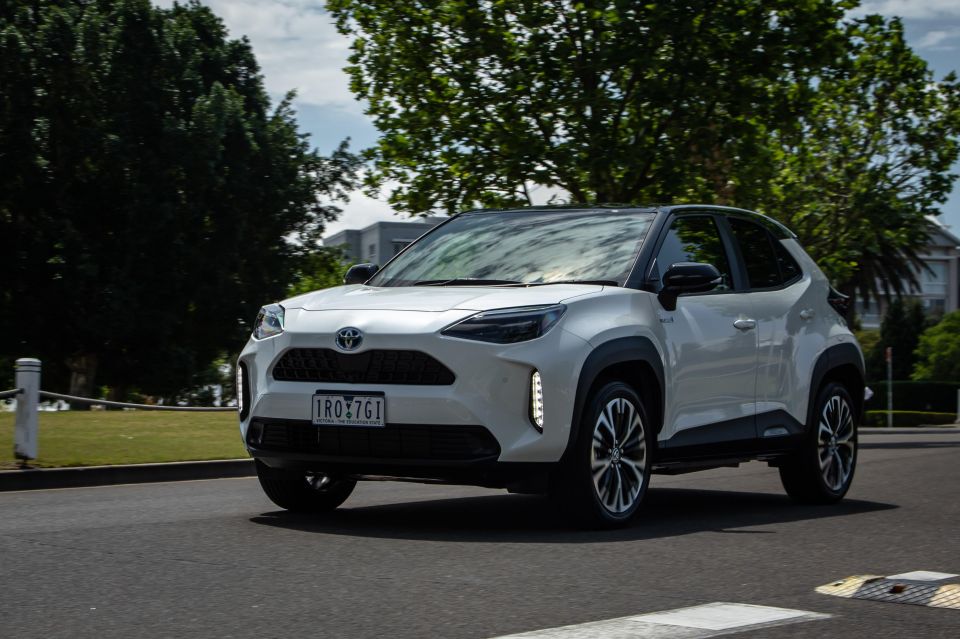
Like its hatchback twin, the jacked-up Yaris Cross sits on TNGA architecture making for a solid foundation for a potentially quality drive on- or off-road. Just how far you’ll brave the latter depends on your faith in traction of those road-focused 215/50 18-inch Dunlop tyres, let alone risk of damage to those fetching rims.
Let’s face it, the ‘E-Four’ on-demand rear-axle drive to create all-paw traction isn’t as off-road fitting as dedicated, mechanically connected all-wheel drive. There is no clever differential hardware or reduction drive to lend a helping hand or three out in the sticks.
That said, Normal drive mode is supplemented with a Trail mode designed to electronically control wheelspin through drive, brake and traction modulation as well as a Snow setting for slippery on-road situations.
Adequately testing the E-Four system’s mettle is a test for another day, but perhaps the all-paw system’s most tangible benefit for the lion’s share of owners will be across dicey on-road conditions and well-graded gravel or dirt.
Ideal for trips to the snow or light duty trips into state forests, say. That said, unlike so many petite SUV/crossover offerings, there’s actually decent ground and wheel clearance to provide a reasonable degree of rut-hopping articulation.
Powertrain wise, there’s a choice of Eco and Power modes as well as a dedicated EV mode, though realistically most users will leave the Yaris Cross in Normal with the electro-petrol drivetrain shuffling to the vehicle’s own devices. The result is a bit mixed in every sense.
Yaris Cross starts up in EV mode though the petrol engine rumbles – literally – to life essentially as soon as you want modest acceleration.
Where electric drive is responsive, instant and linear, drive from the three-cylinder engine is less polished and not very resolved. Its gruff rasp under load causes a sonic ruckus and the CVT driveline seemingly pinning the engine to an rpm point independent of speed or acceleration.
In fact, the engine rumbles into and out of action more like a generator for the EV mode than offering a natural sense of forward propulsion. The combination certainly works, in that there’s ample torque on tap from the engine and motor – separately or in tandem – to get a decent hustle on.
It’s just the undignified manner in which it passes drive around and the sheer noise of the thing that rob its drive prowess of much satisfaction. Compounding matters is that at low speed and light throttle the powertrain produces a faint shudder or palpitation, if most noticeably when the engine is cold.

Where expert car reviews meet expert car buying – CarExpert gives you trusted advice, personalised service and real savings on your next new car.
That’s a shame, because there’s a decent chassis underneath Yaris Cross deserving of a better powertrain performance – the petrol-only version could be a real sweetie. The steering is light and direct, and there’s a clear and crisp edge to the dynamics.
It feels small, lithe and easy to chuck around the urban environment. That said, the regenerative braking is a bit touchy, though it’s only really annoying at low speed, particularly when reverse parking. The reversing camera meanwhile – with its multiple views – is a bit grainy if handy enough with its adaptive guidelines.
Does the on-demand all-wheel drive bring much to the party? Perhaps in challenging conditions, though whatever action it brings to casual around town driving is too subtle to judge as being convincingly beneficial, let alone necessary.
The ride quality could be better, especially given the multi-link design and the suggestion by way of the ride height, that there’s a good degree of pliancy tuned in. Instead the high-rider is just too firmly set, especially across the rear axle, and for this sort of vehicle unnecessarily so.
The Yaris Cross doesn’t seem to offer the sort of balanced compliance I remember from the C-HR, and the underpinnings are noisy – you can hear the hardware conspicuously moving about underneath.
The camera system is a bit grainy and fish-eyed but the Yaris Cross is easy to judge in a tight space while offering a quite concise 10.6-metre turning circle.
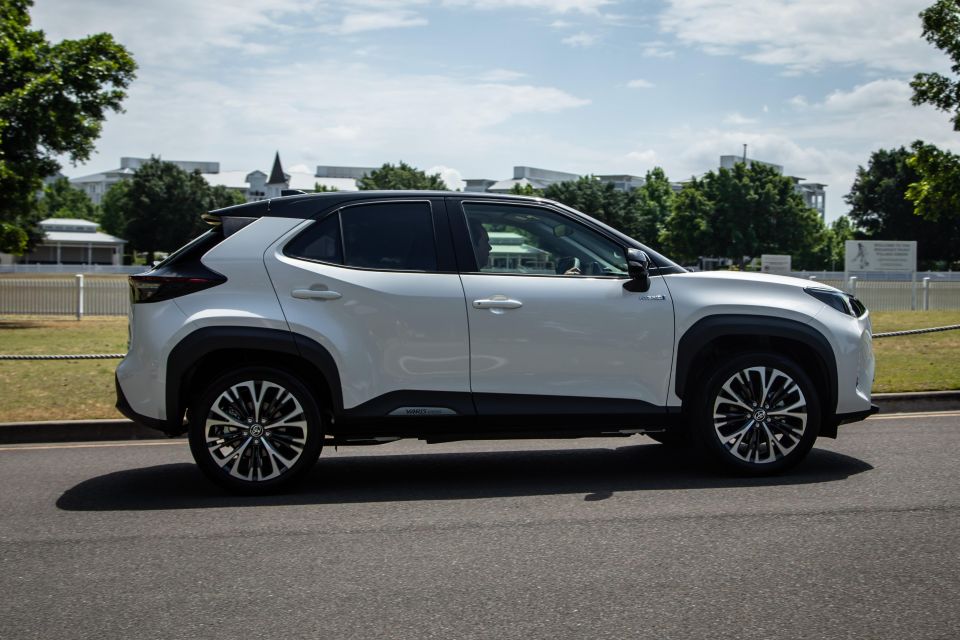
For whatever reason, our assessment vehicle packed a few gremlins on pick-up, namely pre-collision (including AEB) and LTA (lane tracing/keeping) system failures that, according the driver’s screen, demanded a visit to my local dealership. According to the owner’s manual on hand, these are common symptoms of battery disconnection, a likely scenario when transporting these pre-launch test cars out to journalists.
No markdown, then, though I can’t tell you how well or not lane keeping/lane tracing works. What does work, is whatever system – presumably the Intersection Assistance – that decided to cut nearly all drive while I was attempting to exit a side street onto fast-moving traffic on a busy Parramatta Road. A sudden shutdown of power right when you really need it is quite the wake-up call, believe me.
The Yaris Cross likes to bing, bong, chime or buzz relentlessly. It does so three times on start-up for reasons unknown – though one is surely for me to visit my friendly Toyota dealer – and once at shutdown to ‘check the rear seat’, presumably for offspring I must’ve forgotten about, in which case why no alert at start-up to remind in the event I forgot to load them in in the first place?
It also constantly reminds me of entering or exiting school zones over and over again, even when well out of actual school times. If you commit time to digging through sub menus there’s an off button.
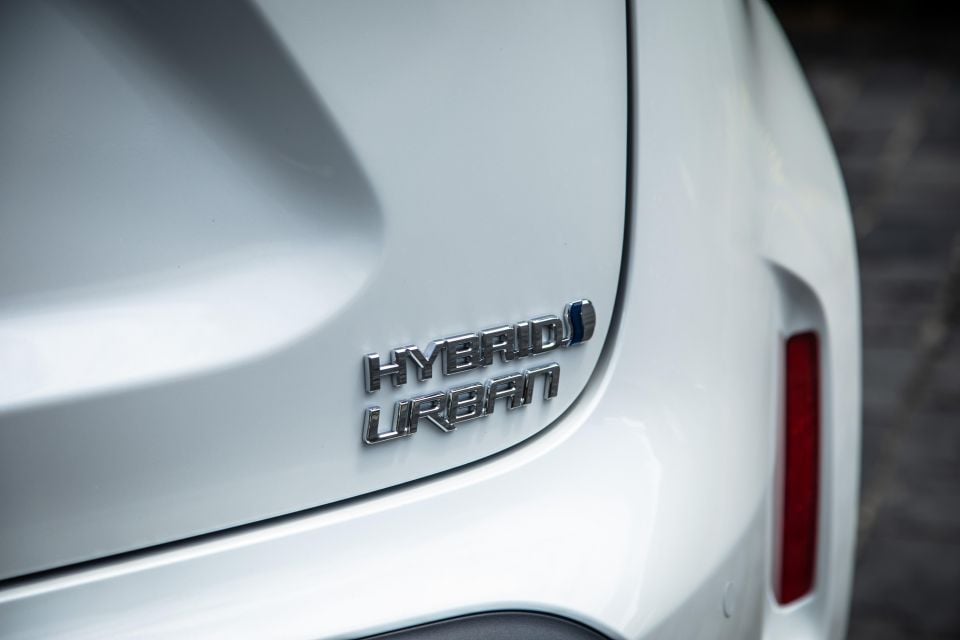
The Yaris is covered by five-year/unlimited-kilometre warranty.
Servicing intervals are a typical 12 months or 15,000kms, whichever comes first, with each visit capped at $205 per year for the first five years.
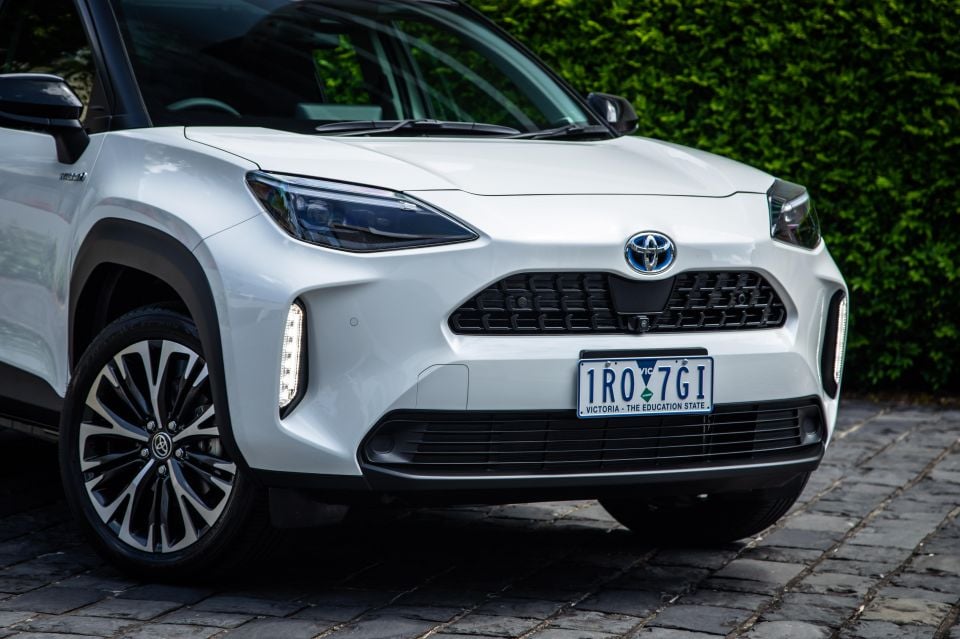
The Yaris Cross Urban AWD Hybrid – and perhaps the mid-spec GXL – brings an interesting technical cocktail to the pint-sized crossover SUV set.
It just doesn’t convert that impressively in the experience. While the hybrid powertrain seems to return rewards as promised in frugality, it’s not nearly as resolved and satisfying to drive as it otherwise should be. It’s not nearly as sorted and transparent in operation as, say, the hybrid system in the Corolla.
Nor does it seem as fun and comfortable as my memories recollect of the C-HR, or quite as well-sorted as the aforementioned Corolla. The high ride and low-profile rolling stock seem more like fashion than function, too, which more or less sums up the whole Yaris Cross experience.
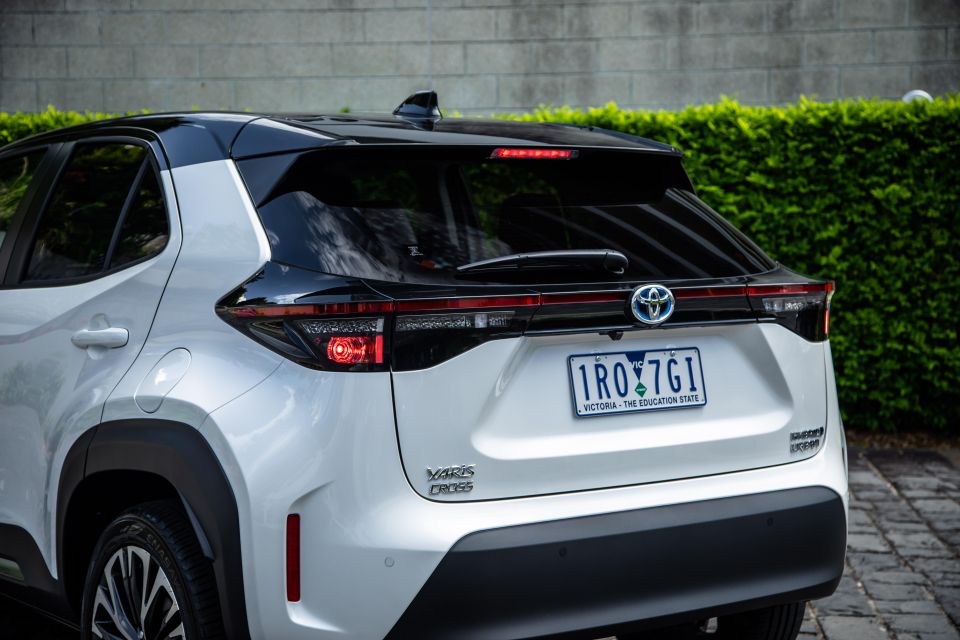
Realistically, you’re buying into a statement of style – if wrapped in a solid shield of new-school safety tech if you can stomach its persistent nagging.
I can’t help feeling the Yaris Cross package becomes smarter and more practical – larger boot, spare wheel – further down the range and it wouldn’t surprise me if the front-driven petrol version is a more integrated driving experience.
The regular GXL at $29,990 could well be the sweetest spot. For that, we’ll have to wait and see.
Where expert car reviews meet expert car buying – CarExpert gives you trusted advice, personalised service and real savings on your next new car.


Damion Smy
13 Hours Ago


CarExpert.com.au
5 Days Ago


Damion Smy
5 Days Ago


Damion Smy
6 Days Ago


Josh Nevett
6 Days Ago


Max Davies
6 Days Ago